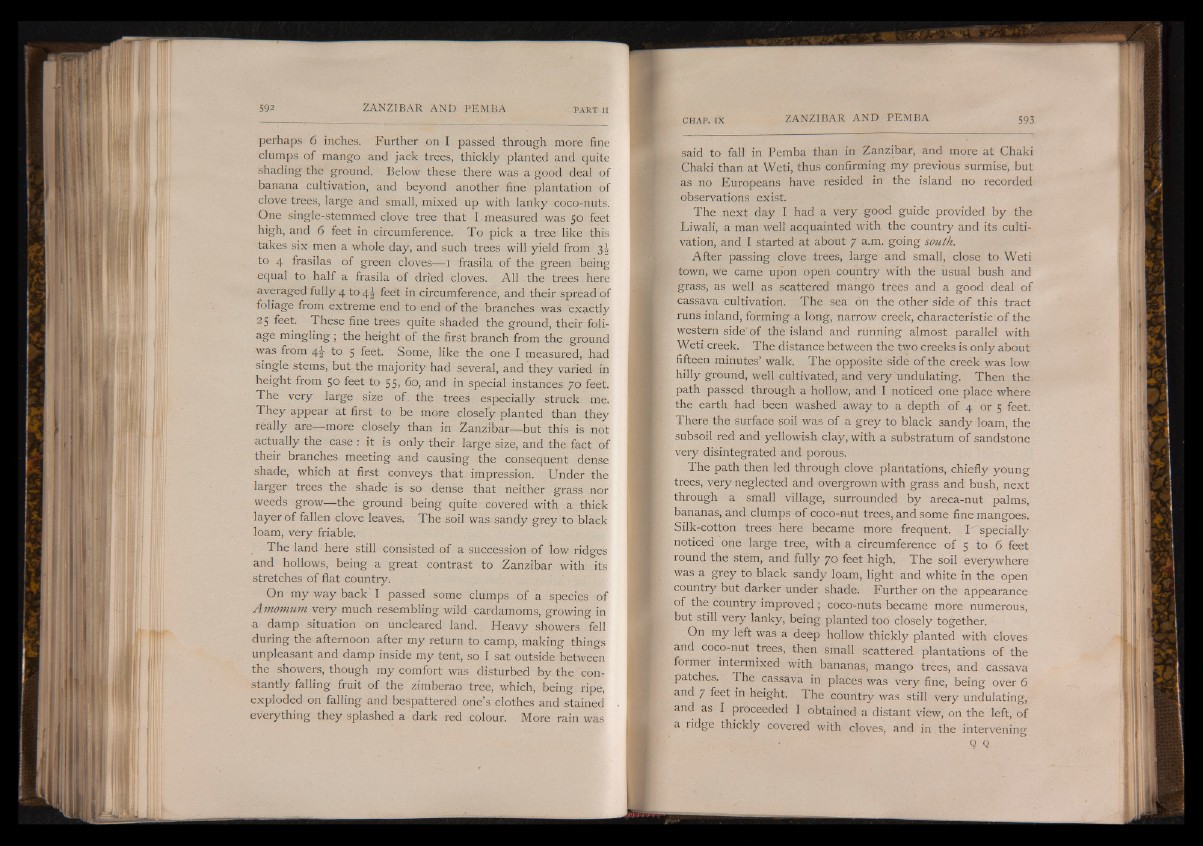
perhaps 6 inches. Further on I passed through more fine
clumps of mango and jack trees, thickly planted and quite
shading the' ground. Below these there was a good deal of
banana cultivation, and beyond another fine plantation of
clove trees, large and small, mixed up with lanky coco-nuts.
One single-stemmed clove tree that I measured was 50 feet
high, and 6 feet in circumference. To pick a tree like this
takes six men a whole day, and such trees will yield from 3J
to 4 frasilas of green cloves— 1 frasila of the green being
equal to half a frasila of dried cloves. All the trees here
averaged fully 4 to 4 | - feet in circumference, and their spread of
foliage from extreme end to end of the branches was exactly
25 feet. These fine trees quite shaded the ground, their foliage
mingling; the height of the first branch from the ground
was from 4|~ to 5 feet. Some, like the one I measured, had
single stems, but-the majority had several, and they varied in
height from 50 feet to 55, 60, and in special instances 70 feet.
The very large size of. the trees especially struck me.
They appear at first to be more closely planted than they
really are— more closely than in Zanzibar— but this is not
actually the case : it is only their large size, and the fact of
their branches meeting and causing the consequent dense
shade, which at first conveys that impression. Under the
larger trees the shade is so dense that neither grass nor
weeds grow— the ground being quite covered with a thick
layer of fallen clove leaves. The soil was sandy grey to black
loam, very friable.
The land here still consisted of a succession of low ridges
and hollows, being a great contrast to Zanzibar with its
stretches of flat country.
On my way back' I passed some clumps of a species of
Amomum very much resembling wild cardamoms, growing in
a damp situation on uncleared land. Heavy showers fell
during the afternoon after my return to camp, making things
unpleasant and damp inside my tent, so I sat outside between
the showers, though my comfort was disturbed by the constantly
falling fruit of the zimberao tree, which, being ripe,
exploded on falling and bespattered one’s clothes and stained
everything they splashed a dark red colour. More rain was
said to fall in Pemba than in Zanzibar, and more at Chaki
Chaki than at Weti, thus confirming my previous surmise, but
as no Europeans have resided in the island no recorded
observations exist.
The next day I had a very good guide provided by the
Liwali, a man well acquainted with the country and its cultivation,
and I started at about 7 a.m. going south.
After passing clove trees, large and small, close to Weti
town, we came upon open country with the usual bush and
grass, as well as scattered mango trees and a good deal of
cassava cultivation. The sea on the other side of this tract
runs inland, forming a long, narrow creek, characteristic of the
western side’ of the island and running almost parallel with
Weti creek. The distance between the two creeks is only about
fifteen minutes’ walk. The opposite side of the creek was low
hilly ground, well cultivated, and very undulating. Then the
path passed through a hollow, and I noticed one place where
the earth had been washed away to a depth of 4 or 5 feet.
There the surface soil was of a grey to black sandy loam, the
subsoil red and yellowish clay, with a substratum of sandstone
very disintegrated and porous.
The path then led through clove plantations, chiefly young
trees, very neglected and overgrown with grass and bush, next
through a small village, surrounded by areca-nut palms,
bananas, and clumps of coco-nut trees, and some fine mangoes.
Silk-cotton trees here became more frequent. Especially
noticed one large tree, with a circumference of 5 to 6 feet
round the stem, and fully 70 feet high. The soil everywhere
was a grey to black sandy loam, light and white in the open
country but darker under shade. Further on the appearance
of the country improved ; coco-nuts became more numerous,
but still very lanky, being planted too closely together.
On my left was a deep hollow thickly planted with cloves
and coco-nut trees, then small scattered plantations of the
former intermixed with bananas, mango trees, and cassava
patches. The cassava in places was very fine, being over 6
and 7 feet in height. The country was still very undulating,
and as I proceeded I obtained a distant view, on the left, of
a ridge thickly covered with cloves, and m the intervening
9 Q